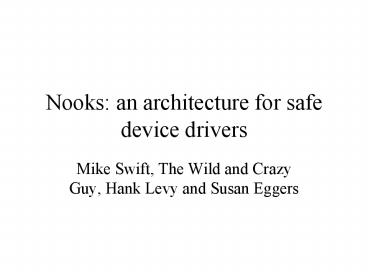Nooks: an architecture for safe device drivers - PowerPoint PPT Presentation
Title:
Nooks: an architecture for safe device drivers
Description:
But I now have three computers in my office and two at home... Hacks for evaluation. Don't run with separate page table. Just flush TLB instead ... – PowerPoint PPT presentation
Number of Views:58
Avg rating:3.0/5.0
Title: Nooks: an architecture for safe device drivers
1
Nooks an architecture for safe device drivers
- Mike Swift, The Wild and Crazy Guy, Hank Levy and
Susan Eggers
2
What are the big problems?
- Performance?
- Solved by Intel
- Functionality?
- Solved by Microsoft
- Scalability?
- Solved by Akamai
- Reliability?
- Solved by Boeing, NASA
3
Reliability is the problem
- When do my parents call me?
- When their computer crashes.
- Reliability is getting better!
- Computers now execute 100x more cycles between
crashes than 10 years ago - But that was on a 486-33
- But I now have three computers in my office and
two at home - But my computers are on 24x7 so I can check the
weather faster
4
Windows 2000 Failure Analysis.
NT4
Source Brendan Murphy, Sample from PSS Incidents
5
Drivers are the culprit!
- 32 of NT 4 faults, 27 of W2k faults
- Microsoft knows how to fix bugs
- Drivers are the bulk of the code in the kernel
- Accounts for largest portion of source code
- Accounts for large portion of runtime code
- Hardware failures make things worse
6
Why are drivers hard?
- Not written by software companies
- Challenging programming environment
- Absolute correctness required
- Complex asynchronous device protocols
7
What can we do about it?
- There have been past projects on isolating code
- Multics
- Microkernels Mach, L4, Fluke
- Extensible kernels Spin, Exokernel, Vino
- Safe code SFI, Java
- Why not isolate drivers?
8
Goals
- Preserve investment in existing OS
- Dont require rewrite of large portions of kernel
- Preserve investments in existing drivers
- Allow existing drivers to execute safely with
just recompilation - Allow different isolation techniques for
different drivers, depending on needs - SFI for low-latency
- VM protection for high-throughput
9
Why is this feasible?
- Drivers
- Have a limited interface to kernel
- Have limited dependencies from other code
- Are designed to be loaded/unloaded independently
- Make few performance-critical calls-backs into
kernel
10
How hard is this?
- What makes it hard?
- Shared state between drivers and kernel
- Weak processors
- What makes it easy?
- Read only parameters
- Void functions
11
Architecture
12
Optimizations
- Defer as much work as possible
- Timers are only manipulated when already context
switching - Packets are only received when context switching
- Provide local resource pools
- Local pool of socket buffers, stacks, local heaps
13
Implementation
- Implemented in Linux 2.4.10
- 147 call into kernel
- 10 interfaces to drivers
- File operations, VM operations, network device
operations, timers, interrupts - 103 calls into drivers
- Duplicated kernel page table grants drivers
read-only access to kernel memory - Lowered privileg level prevents drivers from
deadlocking
14
Wrapping and Protection
- Protection domain switch when calling into
drivers - Identify all calls to/from kernel
- Implement wrapper functions for all calls
- Grant drivers read-only access to kernel memory
- Trap privileged instructions when running at with
lowered privileges
15
Hacks for evaluation
- Dont run with separate page table
- Just flush TLB instead
- Dont run with lowered privileges
- Just trap to kernel at appropriate times
16
Evaluation
- Test platform Blackbox machines
- 1.7 GHz P4
- 1 GB sdram
- Intel PRO/1000 gigabit Ethernet NIC
- 200 microsecond round trip time
- Configurations
- Isolate performance impact of wrapping calls,
flushing TLB, trapping to kernel
17
(No Transcript)
18
(No Transcript)
19
(No Transcript)
20
(No Transcript)
21
Ongoing / Future work
- Create page table structure for safe drivers on
IA-32 - Allow recovery of drivers without full restart
- Hardware is idempotent
- Rather than rebooting driver, just retry request
22
Conclusions
- Operating systems should remove their dependence
on driver safety - Processors are fast enough spend a little
performance on isolation - Existing operating systems can be extended to run
existing driver code safely































